Why LED lamps burn when the switch is off: reasons and solutions
Do you know why LED lights stay on when the switch is off? Agree: problems in the functioning of the lighting system will not please anyone. Do you prefer to find the cause of the LEDs on your own without involving an electrician? However, you don’t know where the weak point is?
We will show you how to deal with a difficult problem. The article describes the most common situations that cause lamps to glow after they are turned off. Ways to solve the problem are considered, recommendations are given for choosing a reliable light source from a trusted manufacturer.
The measures we recommend will allow you to avoid a number of difficult situations during the further operation of such devices. The special design of LED lamps guarantees economical electricity consumption and a long service life.
The content of the article:
LED lamp design
In order to find out the reason for the device to glow after turning it off, you need to carefully examine the design of the LED device, and also find out the principle of its operation.
The design of such a lamp is quite complex; it consists of the following elements:
- Chips (diodes). The main element of a lamp that produces a stream of light.
- Printed aluminum board on a heat-conducting mass.This component is designed to remove excess heat to the radiator, thereby maintaining the temperature in the device that is necessary for the correct operation of the chips.
- Radiator. A device to which heat energy removed from other components of the LED lamp is supplied. Typically this part is made of anodized aluminum alloy.
- Base. A lamp base designed to connect to a lamp socket. As a rule, this element is made of brass, coated with a layer of nickel on top. The applied metal resists corrosion while promoting contact between the device and the socket.
- Base. The lower part adjacent to the base is made of polymer. Thanks to this, the housing is protected from electric shock.
- Driver. A unit that ensures stable, uninterrupted operation of the device even in the event of a sharp change in voltage drops in the electrical system. The operation of this unit is similar to a galvanically isolated modulator of an electric current stabilizer.
- Diffuser. A glass hemisphere covering the top of the device. As the name suggests, the part is designed to maximize the dispersion of the light flux emitted by the diodes.
All components of the device are connected to each other, which ensures its reliable operation.
Operating principle of the equipment
Specific circuits of LED devices produced by different manufacturers may differ significantly from each other. However, they are all based on a general operating principle, which can be schematically depicted as follows.
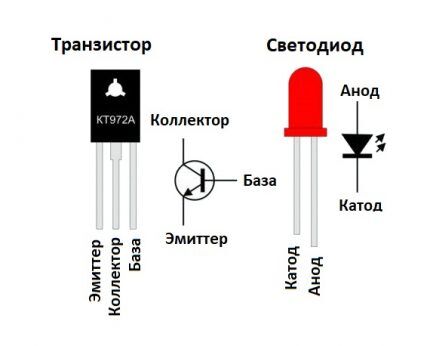
When turned on LED lampconnected to the electrical network, a chaotic movement of electrons begins inside the cylinder. Colliding with each other and holes in the region of the pn junction - the contact of two semiconductors with different types of conductivity - the particles are converted into photons, due to which light radiation occurs.
To optimize the process, additional devices can also be used, for example, different types of resistors or current-limiting elements.
Pros and cons of LEDs
Such products have gained popularity among the population due to a number of positive qualities. Their main advantage is their efficiency: the lamps have a long service life, which is confirmed by a three-year warranty. In addition, they require a minimal amount of energy to function.
Environmental safety is also an important advantage. LED devices do not emit ultraviolet waves, which can harm living organisms. They are designed without hazardous materials, making them easy to dispose of.
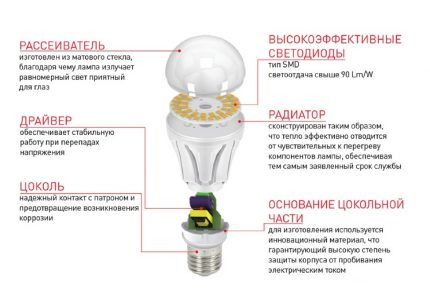
The disadvantages of LED devices include, first of all, their high cost. It should also be taken into account that their work has specific features: sometimes LEDs flash or do not turn off even after the switch is turned off.
These disadvantages are caused by the conservation of charge that accumulates in the capacitor. A weak pulsating current leads to flashing, and a stronger one creates a long-lasting glow.
How harmful are burning lamps?
As mentioned above, one of the most common problems with LED operation is the inability to completely turn off the light source. The lamps continue to burn at approximately 5% of normal power for several minutes or even hours.
Sometimes dim lighting tires apartment dwellers, but some use dimly lit lamps as night lights.
It is worth adding that the defect does not have a harmful effect on the condition of the wiring, and energy consumption increases extremely slightly, since LEDs consume a small amount of electricity.
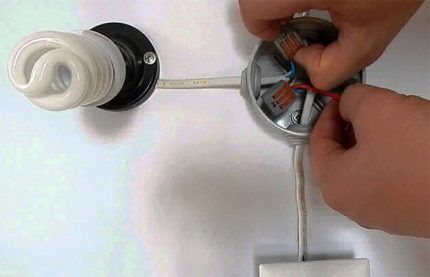
However, experts advise eliminating the problem as soon as possible, since the residual glow of LEDs significantly reduces their service life. In addition, the reasons that cause this phenomenon can lead to serious troubles.
Main causes of residual glow
The reasons that cause LEDs to burn can be different.
The most common ones include:
- Problems related to the electrical wiring installed in the apartment. This may be a broken section of the electrical circuit or a violation of the insulation of one of the wires.
- Incorrect connection diagram of the device to the switch or electrical panel.
- The use of a backlit switch, as well as the use of other difficult to compatible devices: sensors, modules, timers, etc.
- Low quality of the devices used or individual features of the models.
Below we will look at each of the reasons in detail, also indicating measures that can help solve problems in various cases.
Reason #1 - switch with backlight option
If you have a problem with constantly burning lamps, you should first look at the switch. According to electricians, the most common cause of this phenomenon is the use of backlit switch.
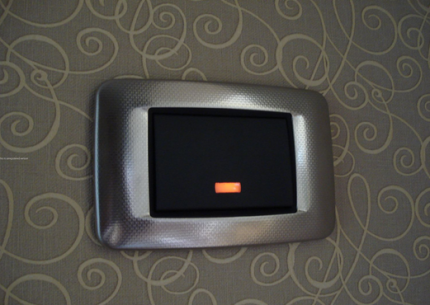
In this case, the devices come into conflict: even a switched off switch cannot completely open the electrical circuit due to the backlight, which is powered through a resistance. Since the system remains open, a small voltage reaches the lamp, which causes a dim glow.
Similar problems can be caused when using other electrical devices: photocells, timers connected to lamps motion sensors and light.
How to solve this problem. Since such a defect with LED lamps that light up even when the switch is off is quite common, electrical specialists have accumulated a lot of experience in correcting the situation.
These may be the following options:
- switch replacement;
- turning off the backlight;
- installation of an additional resistor;
- replacing one of the lamps in the chandelier with a weaker analogue;
- use of resistance with a high power rating.
The easiest way is to replace the backlit switch with a standard switch model without additional function.However, such a solution is associated with additional monetary costs, as well as with reinstallation of the device.
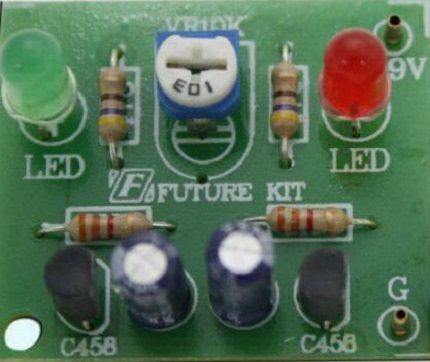
If the presence of backlighting on the switch is not important, you can simply use wire cutters to cut through the resistance that sets the power supply for it. Adding a shunt resistor will help turn off the LED while maintaining the backlight. A device with a resistance exceeding 50 kOhm and a power of 2-4 W can be purchased at a specialized store.
To connect it, you need to remove the lampshade from the lamp, and then attach the wires coming from the device to the terminal block with network conductors, which will allow you to connect parallel to the lamp.
In this case, the current passing through the LED will not flow through the driver capacitor, but through the newly connected node. As a result, reactance recharging will stop and the LEDs will go out when the switch is turned off.
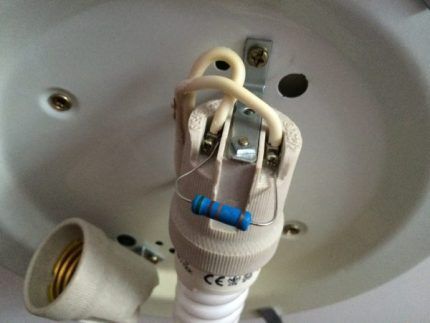
If a problem is identified in a multi-arm chandelier, you can install an incandescent lamp with a minimum power in one of the sections, which will collect all the current coming from the capacitor.
A similar solution can be applied to a single-arm chandelier by installing an adapter from one to two sockets. At the same time, when using this method, the weak glow of one bulb will still remain.
The desired result will also be achieved by replacing the usual resistance in the switch with its analogue with a large number of Ohms. However, to perform such a manipulation, you will need to consult an electrician.
Reason #2 - faulty electrical wiring
Quite often, the source of lamps that do not turn off is faulty wiring. If an insulation failure is suspected, high voltage should be applied to the device for several minutes to simulate the conditions that cause breakdowns in the electrical network.
To find the location of damage to a hidden cable, you can also use homemade or professional products designed for this purpose.
If the problem really lies in worn-out insulation, the electrical wiring in the apartment must be partially or completely replaced. With open cable routing, the process will take a minimum of time and effort. More difficult work awaits if hidden wiring was installed in the housing, walled up in the walls.
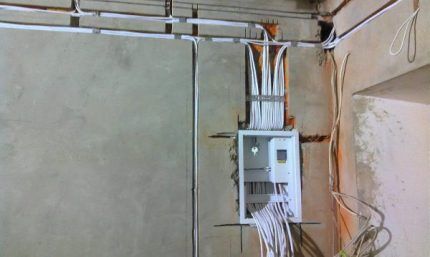
In this case, decorative finishing, such as wallpaper, as well as plaster, will have to be removed from vertical surfaces. After opening the groove where the wires are located, the entire cable or damaged section is replaced. Finally, it is necessary to seal the channels with plaster, and then plaster and refinish the walls.
An alternative temporary solution may be to connect a device to the network, for example, a resistor or relay, which provides additional load. Similar devices, the resistance of which is weaker than that of LEDs, are connected in parallel to luminous lamps.
In this case, the current is redirected, which is why the operation of LED devices is regulated: the light goes out immediately after the switch is turned off. The newly connected element will also not function due to low resistance.
Reason #3 - incorrect connection of the lamp
The reason for the continuous burning of the lamp may be hidden in connection errors. If, when installing the switch, a zero was connected instead of a phase, it will turn off when the circuit is opened.
At the same time, due to the retained phase, the wiring will still be energized, which is why the device will glow when the switch is turned off.
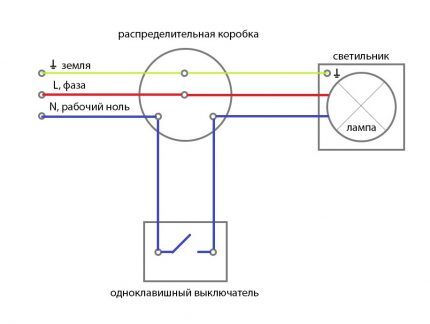
This situation is quite dangerous for the inhabitants of the apartment: since the device is energized, even if it is turned off, you can accidentally receive an electric shock. To correct the situation, you need to turn off the power supply, then disconnect the wires, and then mount them in the correct way.
Reason #4 - poor quality of the light bulb
Quite often the cause of the malfunction is the poor quality of the LED used, which must be replaced with a working one. In order to encounter such problems as rarely as possible, it is better to buy certified products from brands such as Philips, Gauss or A.S.D.,
Russian brand products have proven themselves well JAZZway and Era.
True, the persistence of the glow can also be observed in devices manufactured by reputable manufacturers.It may be caused by functional features in the operation of lamp resistors.
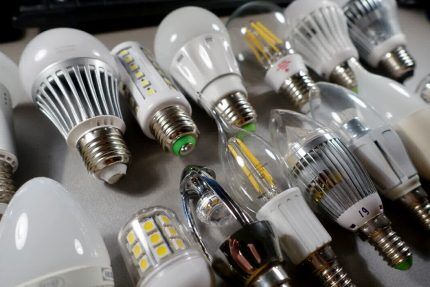
So, when an electric current is applied, thermal energy can accumulate in the device, which is why the LED will remain on even after it is turned off, albeit for a short time. Companies combat this phenomenon by using resistors in the manufacture of equipment made from materials that prevent the accumulation of excess heat energy.
Recommendations for choosing electrical appliances
One of the important factors for the smooth operation of LED lamps is the choice of products of appropriate quality. In this case, one should take into account the features under which the devices will have to function, as well as their compatibility with other equipment connected to the power grid.
Before purchasing, it is recommended to carefully read the instructions supplied with the LED devices, which indicate the operating rules. Please note that a number of popular devices, such as dimmers for LEDs, timers, photovoltaic modules can cause problems with the LEDs.
It is also important to carefully examine the appearance of the light bulb, paying attention to the joint between the body and the base, which should be securely adjacent to the main part without any defects. If there are scratches, dents or sloppy seams, the likelihood of problems with the glow increases significantly.
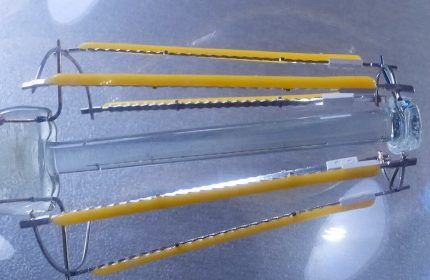
An element such as a radiator is important. It is best to choose an LED in which it is made of aluminum, but ceramic and graphite analogues also have high performance. The size of this part, which is responsible for the removal of thermal energy, the release of which can also occur when the light is turned off, is also important.
For a high-power LED to operate correctly, it is necessary to use a large radiator, while for a weak device a compact one will be sufficient.
As a rule, in specialized stores, sellers test turn on the lamp. In this case, you need to try to check the flicker level: the lighting device should emit an even luminous flux without any pulsation.
Since it is quite difficult to assess this factor with the naked eye, it is better to film the device turned on with a mobile phone video camera. The recording will allow you to better evaluate his work.
Conclusions and useful video on the topic
The video reveals the two most common reasons why LED lamps burn even after turning off the power. Detailed instructions for eliminating them are also provided:
The glow of the lamps when the switch is turned off is not only unpleasant for the eyes, but also sharply reduces the life of the LEDs. To eliminate the problem, you need to establish the cause that causes a malfunction in the functioning of the devices, and then eliminate it.
In most cases, correcting the situation will require a minimum of time and effort. You can do the necessary work yourself using basic tools.
Please leave comments in the block below. Share useful information that may be useful to site visitors. Ask questions, tell us about your personal experience in eliminating LEDs from collapsing after switching off, post photos related to the topic of the article.




There was a problem in my parents’ apartment: after turning off the lights, the lamps continued to burn. Not as bright as when turned on, but quite noticeable and long-lasting. Everyone even joked about the abnormality of the fields in the apartment. Deciding to stop this problem forever, they called an electrician, he made a disappointing diagnosis: replacing a huge section of wiring. And this, for a moment, is wall shingling, noise, garbage and other joys. But safety turned out to be more important for us. After completely replacing the old wiring with a more modern and high-quality one, the mysterious glow in the apartment stopped.
At first I also wondered why the LEDs glow after being turned off. And then I stopped even thinking about it when LED floodlights were installed everywhere in the city. Because they all burn for some time in the off state. Although only “octopuses” behave this way at home. Regular E27 lamps do not light up. And long tubular 20 watt ones too. The octopus switches may not be connected correctly. Why then do street floodlights glow when they are turned off?
A year ago, a friend of mine installed sconces with small LED bulbs, everything worked great, but one day they started glowing when turned off. The wiring is excellent, there is a plus on the switch, I checked everything, but did not find the cause.
If the switch is not backlit, and the wiring is normal, then the reason is almost certainly in the light bulb itself. Try replacing it.
Good afternoon, Vali. In electrical supply there is no term “excellent wiring”. It may meet the requirements of the PUE, PTEP or not.
The main indicator of the serviceability of apartment and other wiring is the insulation resistance, which is checked according to an approved method using certain devices. I doubt that you have carried out an instrumental check of the electrical wiring. Attached is a screenshot of the table specifying the test parameters and the value of the minimum insulation resistance from PTEP.
If you are a specialist, please explain why the same light bulb retains an afterglow in only one of the chandelier sockets, while in the same socket where one is lit, the other does not glow immediately after being turned off?
We never had poltergeists and never have!
In your case, it is possible that the chandelier was assembled incorrectly, either by the installer or at the factory. When assembling a chandelier, it is very useful to have a multimeter with a dialing mode. It is necessary to ring the chain from the cartridge. The central contact of the socket is the phase (brown wire), the contact of the base, which is in contact with the threaded part of the lamp, is zero.
I suffered all day with these LEDs, bought other bulbs and changed them, but it turned out that the whole problem was in the backlit switch...
No bullshit. A lot about simple problems and nothing about a weak glow if everything is fine. Is it the same with cars? If you can't fix it, let's replace it.Do you have a Merc? yes, the Merc is not the same today, buy a Hyundai, there will definitely not be such a problem there, there will be ten others...
In your case, it is possible that the chandelier was assembled incorrectly, either by the installer or at the factory. When assembling a chandelier, it is very useful to have a multimeter with a dialing mode. It is necessary to ring the chain from the cartridge. The central contact of the socket is the phase (brown wire), the contact of the base, which is in contact with the threaded part of the lamp, is zero.
According to the diagram, ground and zero are not exactly the same thing!
and the backlit switch gives a stroboscopic effect, but does not burn at half brightness...
I changed the switch and the lights are still on
Video unavailable. Why the hell do we need such a video?
That's right... Not available means NOT needed.
That's right... Not available means NOT needed.